
Search
The Renewable Energy site for Do-It-Yourselfers
Copper/Aluminum
Prototype Performance
Side-by-side
test of Copper/Aluminum collector and PEX/Aluminum collector
This shows the performance of both
the Cu/Al 32 sqft prototype collector and the PEX/Al 32 sqft collector.
|
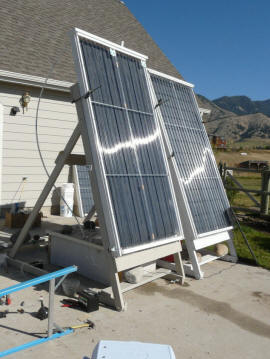
Cu/Al collector to left, and PEX/Al
collector to right. |

Each collector heats 5 gallons of
water in a separate red
insulated ice chest.
The submersible pumps are located
in the ice chests.
Click pictures for full size |
In this test, the Copper tube with Aluminum Fin 32
sqft prototype is run side by side with the
PEX tube with Aluminum Fin prototype
of the same size. Both collectors are oriented the same way. Both
are supplied water from identical 5 gallon insulated ice chests via identical
submersible pumps -- this is like the
small panel test, only with
big panels.
Tambient is about 75F, flow rate is about 3 gpm, and water in each reservoir is
5 gallons (full).
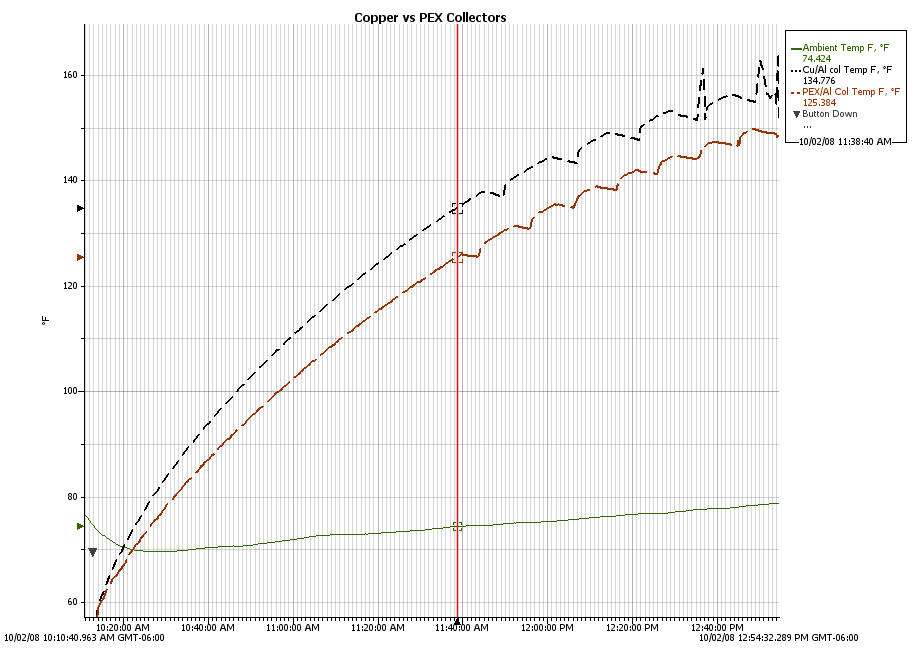
This plot shows the temperature of
reservoirs for each collector.
The black dashed line is the
copper/aluminum collector reservoir temperature (F).
The dark orange long dash line is the
PEX/aluminum collector reservoir temperature (F).
The dips in each line above about
125F are the pumps shutting off for a while because their thermal protection is
tripping, so the part of the plot above these dips should be used with caution.
Both reservoirs start at 60F.
When the Cu/Al has reached 134.7F, the PEX/Al is at 125.4F, so the warm-up for
the Cu/Al is 74.7F, and the warm-up for the PEX/Al is 65.4F. So, the
Cu/Al adds about 14% more heat to the reservoir over the first 1.3 hours.
This agrees well with the results from the
small panel tests.
Both collectors are still increasing
the temperatures of their reservoirs up in the 150F area in spite of the pumps
cutting out at times.
I believe that for all practical
purposes, the Cu/Al collector can be considered equivalent to what a commercial
collector would do (see the small
panel tests for the reasoning behind this), so you can also look at the plot
as a pretty good comparison of how the PEX collector would do relative to a
commercial collector.
The heating rate in this test works
out to about 1 showers worth of hot water per hour for a 32 sqft collector (full
sun).
Copper/aluminum collector alone hooked to 38 gallon
reservoir
In these two tests, the Cu/Al collector is connected to 38 gallons of water in a
galvanized steel stock tank just behind the collector. The stock tank ins
insulated fairly well with 2 inch polyiso insulation board.
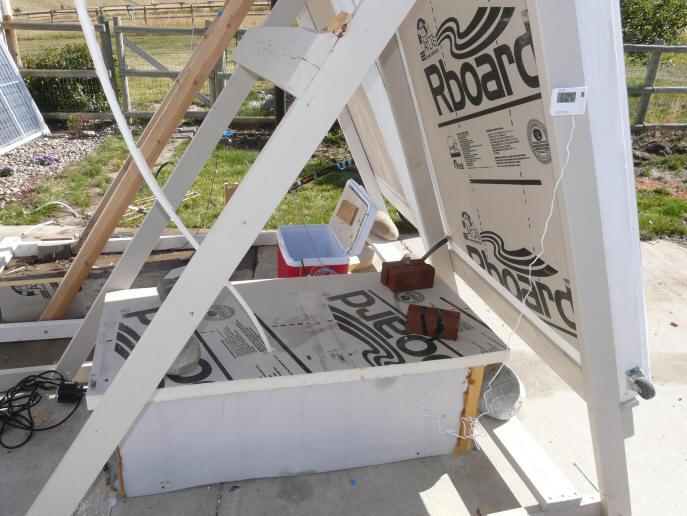
Picture shows the 38 gallon tank with its insulation panels installed.
Day 1:
A small submersible pump that provides about 1.4 gpm flow
was used. The pump is being powered by a 15 watt PV panel for this test.
The plot below shows the temperature of the tank over the course of the day.
I was not able to get started at first sun, so this is a partial day.
Ambient temperature was in the low
70's.
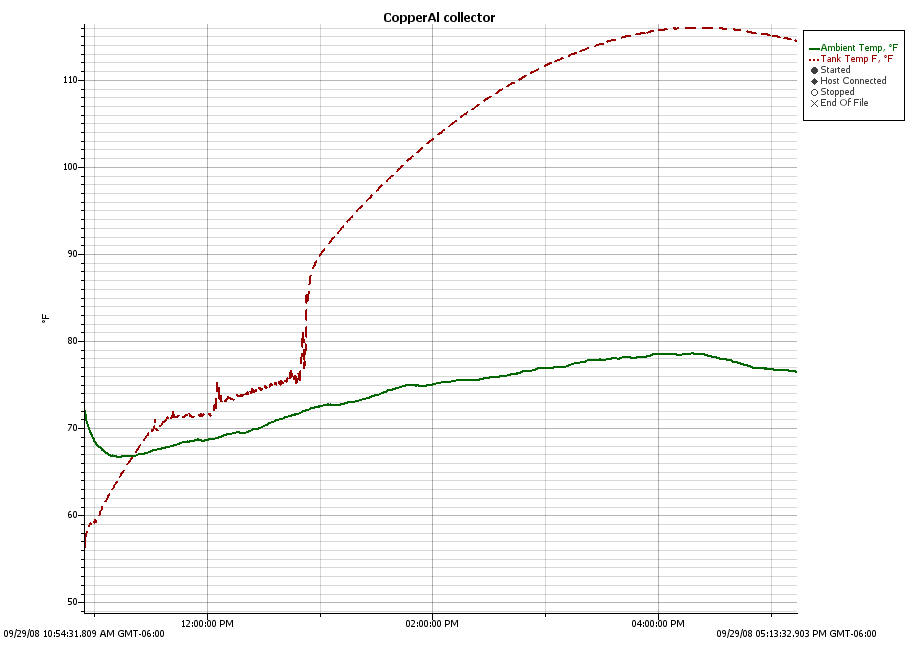
The collector heats the water in the
tank from about 55F up to about 116F.
The rate of temperature change
between 1pm and 2pm when the tank is in the 95F area is about 13 F per hour --
this seems like a good rate for the most important part of the storage tank heat
recovery for a solar water heater.
The interruption in heating rate
starting at about 11:30 am and going until about 12:45 pm was caused by a pump
problem. It appears that without that problem the tank would have gained
about another 5F by the end of the day.
Day 2:
This is the day after the test above,
and starts with the tank partially heated (as it would usually be in a real
system).
The tank starts at 92F, and makes its
way up to 140F.
The leveling off at 140F is due to
time of day rather and increasing afternoon incidence angle.
Same pump and flow rate as Day 1.
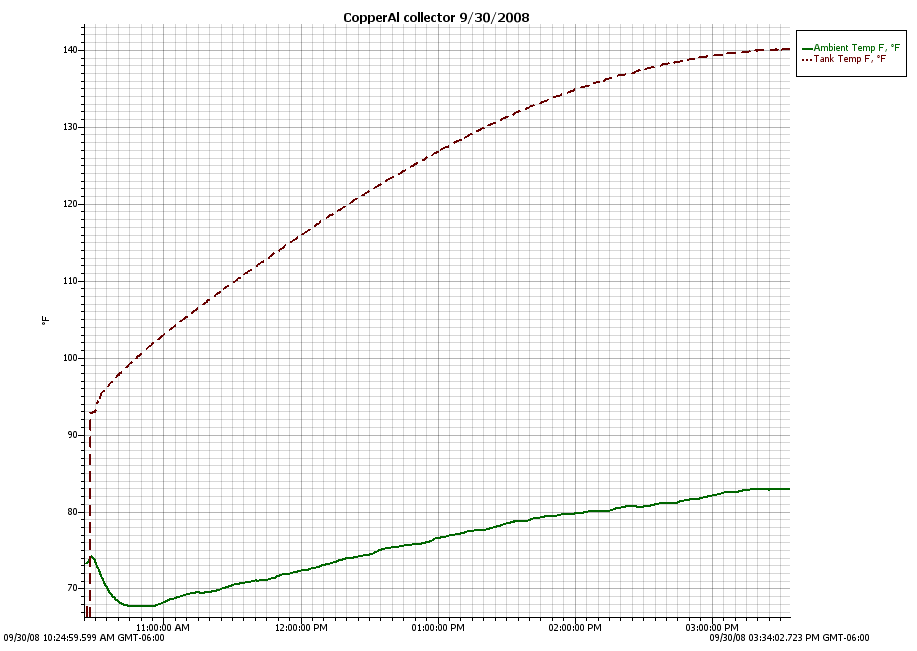

My yard is beginning to look like a northern branch of the SRCC.
Far left in background are the garage/shop solar heater doors, then the
copper/aluminum collector
prototype (on rack), then the PEX/aluminum collector prototype (on rack), and in
the right background is the
PEX/aluminum collector for our actual solar hot water system.
I have a very patient wife.
Gary September 29, 2008, September
30, 2008, October 2, 2008




